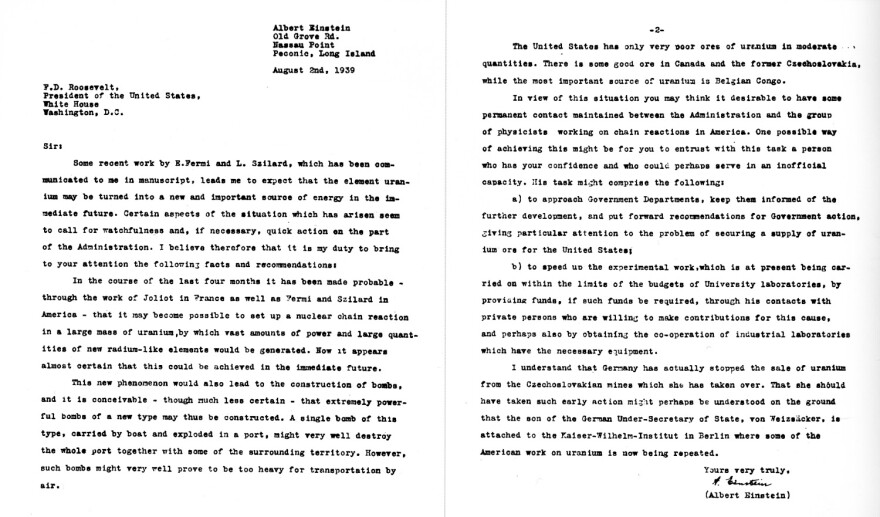What if the atomic bomb dropped on Hiroshima in 1945 failed to detonate?
A writer and an artist ask that question at the Truman Library and Museum as part of Kansas City’s Open Spaces arts festival, which has a roomy-enough sphere of exhibitions for various thought experiments, both the viewers’ and the artists’.
“We have the benefit of hindsight, and I think collectively since that time, we understand that it’s evil to indiscriminately kill mass civilians, and yet our attitude toward nuclear war is shaped by events of the past, and Truman didn’t have those events to draw upon,” says Phong Nguyen, a professor and chair of the writing department at the University of Missouri.
Several years ago, Nguyen wrote a short story called “Einstein Saves Hiroshima,” which was published in his collection “Pages from the Textbook of Alternate History.” That story was where his wife, artist Sarah Nguyen, found the inspiration for the installation “Break into Blossom” now at the Truman Library.
First, there was the actual history. In 1939, physicist Leo Szilard needed a name with more recognition than his own in order to gain President Franklin Roosevelt’s backing in the development of a nuclear bomb — he wanted the United States to create one before Germany did.
Years earlier, Szilard had developed the science for a nuclear chain reaction, the technology that eventually led to the creation of the atomic bomb. Many scientists in the field were frightened of its power and felt the need to warn other nations of its dangerous potential.
Einstein wrote a letter to the Belgium Ambassador to warn that Germany was closing in on its own blueprint for such a weapon.
Szilard took Einstein’s letter of warning and crafted one of his own to Roosevelt suggesting that if the United States didn’t act quickly, Germany would be the first to develop a working model, and the entire world would be at the Nazis’ mercy. All Einstein had to do was sign his name.
Einstein and Szilard later regretted that letter’s existence.

Phong Nguyen imagines what might have happened if Einstein had not signed it: Without funding from the government, he writes, the bomb was not fully operational when, out of desperation to end World War II, President Harry Truman authorized its use on the city of Hiroshima, Japan.
Thinking of this alternate history, Sarah Nguyen says, “Instead of detonating, it fell to the earth and fell through a grove of cherry blossoms and eventually became a memorial to what could have happened.”
It is this fictitious memorial that the couple, along with Warrensburg, Missouri, sculptor Justin Shaw, have created. Shaw constructed an exact replica of the bomb out of construction foam, and Sarah Nguyen gave it several decades’ worth of rust, moss and the illusion of a half-ton of weight.

In their thought experiment, she says, the war ended after both sides saw what could have happened; that the collective thrill of fear followed by relief, was all the world needed to say there would be no more war.
As a kind of evidence for this idea, she notes that in real life, Truman refused to drop a third bomb.
“And the reason is that he saw the devastation” she says. “No one knew what they were releasing when they dropped these two bombs. They had an idea, but not really the extent of it.”

Phong Nguyen doesn’t go that far.
“I have no special knowledge that would allow me to say how the war would end in the absence of such a weapon,” he says.
But that doesn’t keep him from imagining a world in which it never happened at all.
Ultimately, more than it is about anything political, their installation is about turning pain into beauty.
Phong Nguyen named the exhibition after a poem by James Wright called “A Blessing.” He says the poem and the exhibition aren’t obviously related, though perhaps they share some imagery.
The poem is about a transcendent experience — a person transcending his own creature-boundaries so that he understands his living as a part of all life. And the idea of a weapon of mass destruction lying so still beneath cherry blossoms that it transforms into a memorial of the death that could have been, isn’t all that different; each is a matter of utility and perspective.
“Break into Blossom,” 9 a.m. to 5 p.m. Monday through Saturday; noon to 5 p.m. Sunday at the Truman Library and Museum, 500 West U.S. Highway 24, Independence, Missouri 64050. Admission fees may apply.
Follow KCUR contributor Anne Kniggendorf on Twitter, @annekniggendorf.






